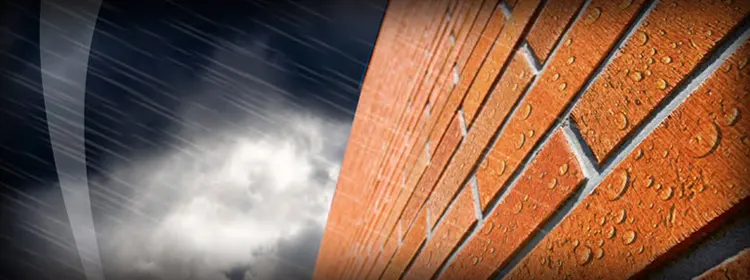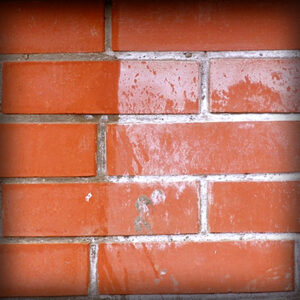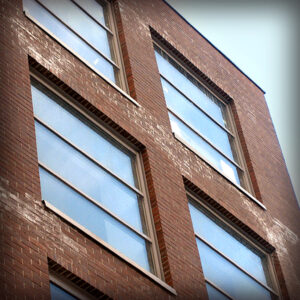Facade Waterproofing Services in Kyiv. Removal of Salt Efflorescence
Waterproofness is a capacity of material to be resistant to penetration by water. Waterproofing of façade means a process of applying special coatings on façade surface up to its full saturation level, which results in ultimate resistance to the ingress of water from outside. Such coatings penetrate into the wall surface to a depth of 2 to 5 mm and form a thin film, which reduces entering water molecules into surface pores by 95%. In most cases, materials used to waterproof facades are colourless, that’s why the façade appearance remains almost unchanged. But if the Customer wants to change the façade colour, it is possible to add colouring agents into the waterproofing coating and to get the desired colour effects, e.g. wet effect. Chemical substances are steadily retained in the material and do not fade away in the long run. Waterproofing extends the useful life of façade up to 15 years and prevents salt efflorescence.
What surfaces can be treated with waterproofing agents?Waterproofing treatment can be carried out on porous hygroscopic surfaces such as concrete, foam concrete blocks, aerated concrete blocks, brick, limestone blocks, lightweight expanded clay aggregate, various types of tiles, sand and cement renders, corrugated fiber cement sheets and slates as well as natural and artificial stone. As described above, façade waterproofing:
- limits content of soluble compounds in walls;
- increases density of building envelope materials and decreases their capillary density and penetration;
- prevents rewetting.
In addition to the above listed advantages, façade waterproofing helps to:
- enhance the thermal insulation characteristics of a surface;
- improve corrosive resistance of a structure and increase frost resistance;
- extend a lifespan of finish coatings and paints;
- prevent microbial growth on façades.
Specific characteristics of the material to be treated help to choose a proper application technique and a type of waterproofing agents. In all cases, with no exceptions, before starting work, a wall should be cleaned from dust, cement traces, dirt and, what is a must, from salt efflorescence. After being cleaned, façade should be dried, and when the temperature is below +5 Сo, it’s time to start waterproofing work.
Relevant experience and expertise of Alp Star rope access technicians allow performing clean-up activities and waterproofing your building as soon as reasonably practicable.
If you want to get free-of-charge consultation or invite our specialist, please contact us at
+380 67 258 2999 or by e-mail at alpstar.kiev@gmail.com
Removal of Salt Efflorescence from Facades
Almost all porous building materials of both artificial and natural origin are subject to salt efflorescence.
Façades can be stained when salts contained in bricks, cement, concrete, mortars, plasters, anti-freezing agents, plasticizers, etc. will come off the wall surface and form crystalline deposit of salts.
The chemical composition of efflorescence is a mixture of calcium, carbonate, potassium and other elements. Some of these elements are dissolved in water, but most of them can be removed only with the help of acid and alkaline solutions.
It should be noted that effloresce appears on the surface if there are the following three conditions are met:- Plasters, concrete or brickwork contain water-soluble salts (often sulphates).
- Enough moisture is required for water to penetrate into the material and for salts to dissolve and to be then brought to the surface. Water carries salts to the surface and begins to evaporate, which makes salt stains invisible. The higher the ambient humidity, the more likely that efflorescence begins to appear as water begins to evaporate directly on the surface.
- The material should be porous to carry a solution to the surface with further crystallization. Therefore, the higher the porosity of material, the stronger its capacity to wash away compounds and to form efflorescence.
It is very important to understand that in the absence of at least one of these three factors, efflorescence is impossible to appear on the surface. But heavy exposure to one or the other factor increases an intensity of salt migration.
Removing Efflorescence from FacadesTo remove efflorescence, special flushing products are used. Salt removing agents should be rather strong to neutralize unwanted compounds and, at the same time, non-aggressive in order not to damage the façade cladding (brick, clinker tiles or rough raw stone).
It is impossible to remove efflorescence with water and brush since water having penetrated into walls moves away a new portion of salt, and rough brushes can damage the cladding.
Alp Star uses up-to-date products of local and foreign producers, which deeply and profusely penetrate into a wall for its full thickness, and compounds contained in such products effectively bring salt traces up to the surface.
After removing efflorescence from the façade, it is ultimately recommended to treat the surface with a proper waterproofing agent. It is of high importance as waterproofing agent can fill in clean pores of the material and prevent appearance of new efflorescence at all.
If you want to get free-of-charge consultation or invite our specialist, please contact us at
+380 67 258 2999 or by e-mail at alpstar.kiev@gmail.com




